University Smart Home Voice Control Hub Prototype Report - COMP1649
VerifiedAdded on 2022/08/21
|24
|5738
|21
Project
AI Summary
This report details the design and development of a smart voice control hub prototype for home automation. The project focuses on creating a mobile application, "Nexon voice control hub", that allows users to control smart devices through voice commands. The report outlines the design process, including research into user-centered design principles, cognitive psychology considerations, and interaction design theories. It presents a high-fidelity prototype developed using Axure RP 9, showcasing various stages such as the greeting page, main menu, device setup, and command execution. The prototype incorporates both touch and voice interaction models. The report also discusses the benefits of smart home automation, including energy saving and convenience, and reviews the interaction design principles applied. Overall, the project aims to provide a user-friendly and efficient smart home control system.

Running head: HUMAN COMPUTER INTERACTION
Human Computer Interaction
Name of the Student
Name of the University
Author Note
Human Computer Interaction
Name of the Student
Name of the University
Author Note
Paraphrase This Document
Need a fresh take? Get an instant paraphrase of this document with our AI Paraphraser
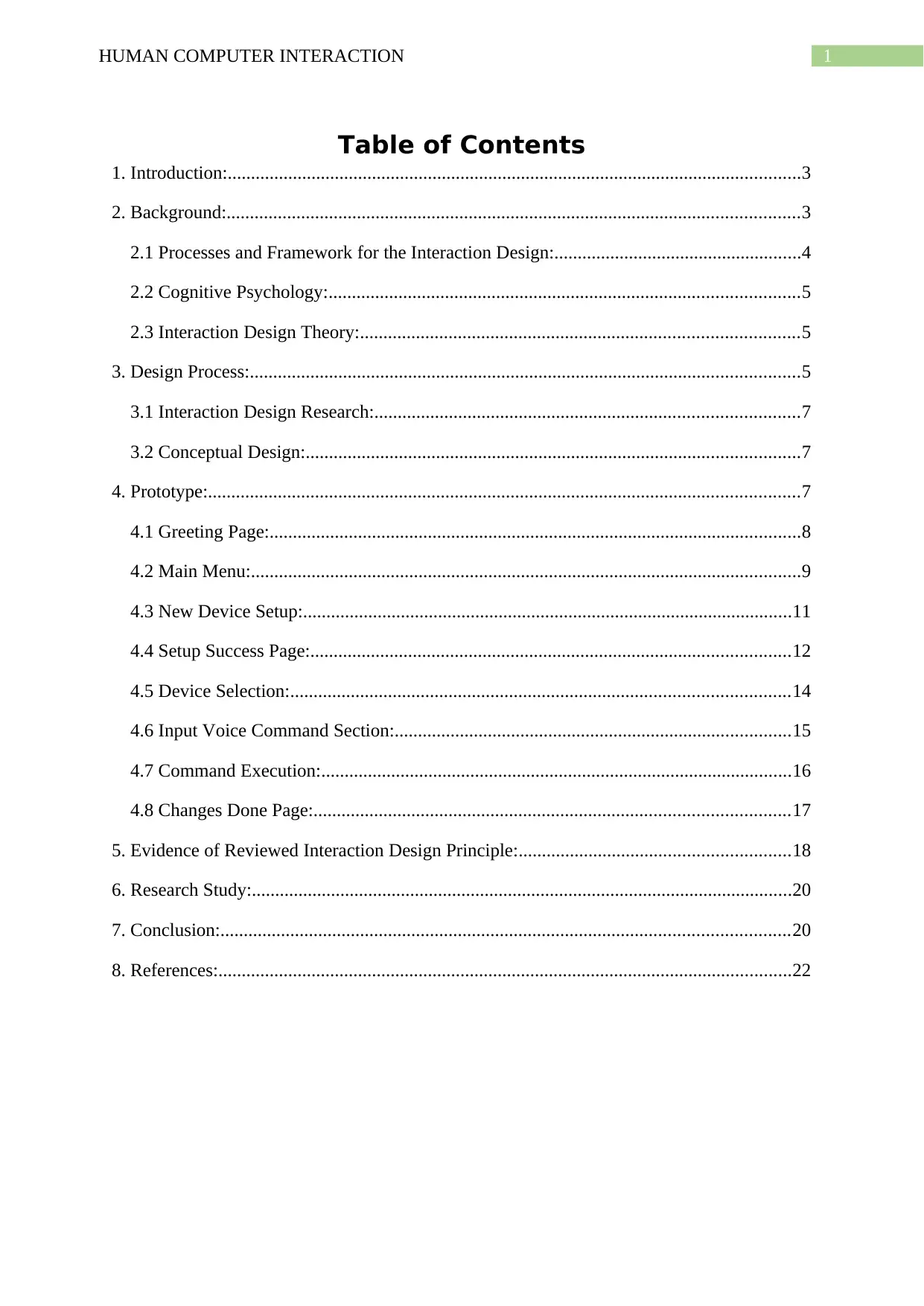
1HUMAN COMPUTER INTERACTION
Table of Contents
1. Introduction:...........................................................................................................................3
2. Background:...........................................................................................................................3
2.1 Processes and Framework for the Interaction Design:.....................................................4
2.2 Cognitive Psychology:.....................................................................................................5
2.3 Interaction Design Theory:..............................................................................................5
3. Design Process:......................................................................................................................5
3.1 Interaction Design Research:...........................................................................................7
3.2 Conceptual Design:..........................................................................................................7
4. Prototype:...............................................................................................................................7
4.1 Greeting Page:..................................................................................................................8
4.2 Main Menu:......................................................................................................................9
4.3 New Device Setup:.........................................................................................................11
4.4 Setup Success Page:.......................................................................................................12
4.5 Device Selection:...........................................................................................................14
4.6 Input Voice Command Section:.....................................................................................15
4.7 Command Execution:.....................................................................................................16
4.8 Changes Done Page:......................................................................................................17
5. Evidence of Reviewed Interaction Design Principle:..........................................................18
6. Research Study:....................................................................................................................20
7. Conclusion:..........................................................................................................................20
8. References:...........................................................................................................................22
Table of Contents
1. Introduction:...........................................................................................................................3
2. Background:...........................................................................................................................3
2.1 Processes and Framework for the Interaction Design:.....................................................4
2.2 Cognitive Psychology:.....................................................................................................5
2.3 Interaction Design Theory:..............................................................................................5
3. Design Process:......................................................................................................................5
3.1 Interaction Design Research:...........................................................................................7
3.2 Conceptual Design:..........................................................................................................7
4. Prototype:...............................................................................................................................7
4.1 Greeting Page:..................................................................................................................8
4.2 Main Menu:......................................................................................................................9
4.3 New Device Setup:.........................................................................................................11
4.4 Setup Success Page:.......................................................................................................12
4.5 Device Selection:...........................................................................................................14
4.6 Input Voice Command Section:.....................................................................................15
4.7 Command Execution:.....................................................................................................16
4.8 Changes Done Page:......................................................................................................17
5. Evidence of Reviewed Interaction Design Principle:..........................................................18
6. Research Study:....................................................................................................................20
7. Conclusion:..........................................................................................................................20
8. References:...........................................................................................................................22
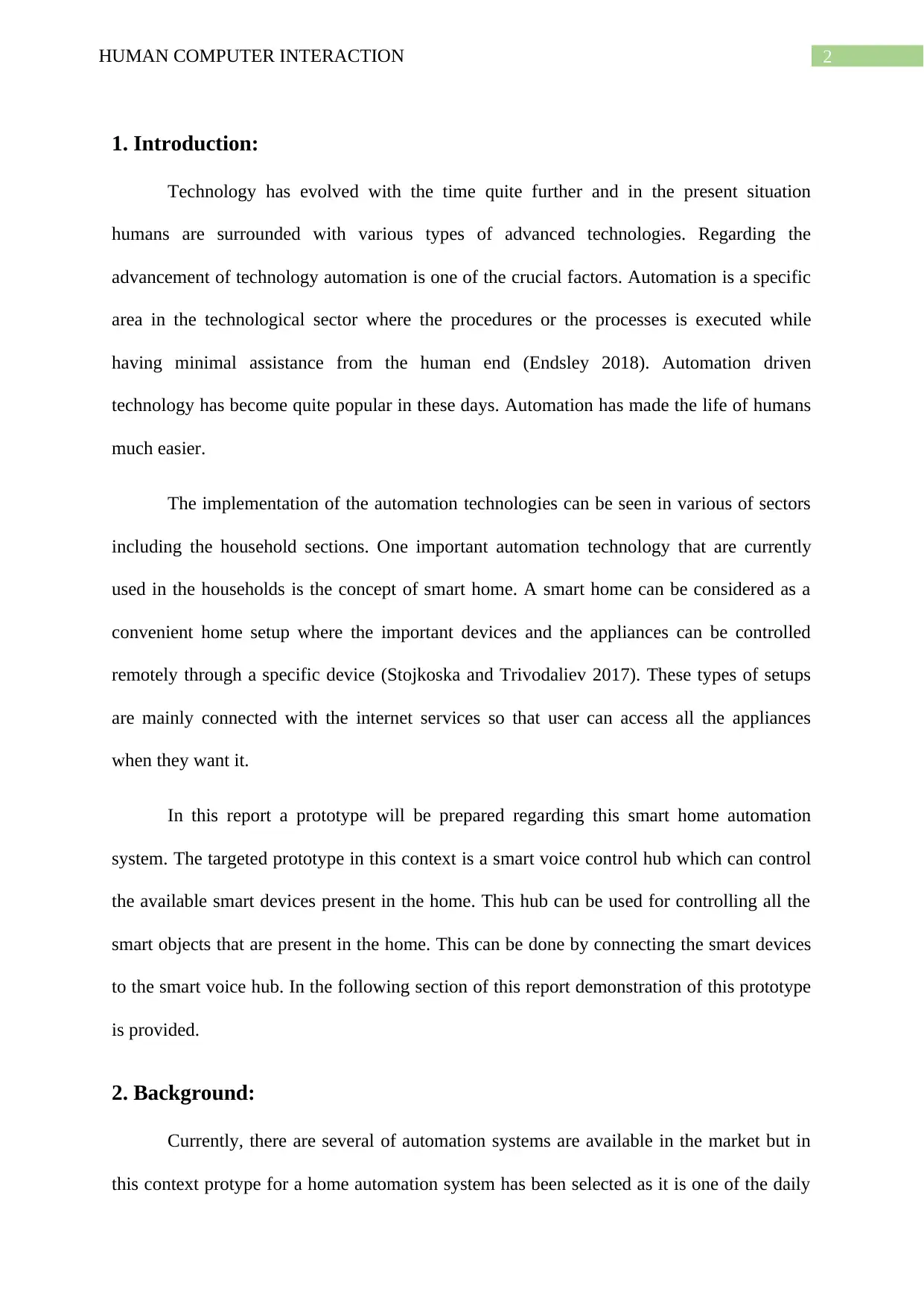
2HUMAN COMPUTER INTERACTION
1. Introduction:
Technology has evolved with the time quite further and in the present situation
humans are surrounded with various types of advanced technologies. Regarding the
advancement of technology automation is one of the crucial factors. Automation is a specific
area in the technological sector where the procedures or the processes is executed while
having minimal assistance from the human end (Endsley 2018). Automation driven
technology has become quite popular in these days. Automation has made the life of humans
much easier.
The implementation of the automation technologies can be seen in various of sectors
including the household sections. One important automation technology that are currently
used in the households is the concept of smart home. A smart home can be considered as a
convenient home setup where the important devices and the appliances can be controlled
remotely through a specific device (Stojkoska and Trivodaliev 2017). These types of setups
are mainly connected with the internet services so that user can access all the appliances
when they want it.
In this report a prototype will be prepared regarding this smart home automation
system. The targeted prototype in this context is a smart voice control hub which can control
the available smart devices present in the home. This hub can be used for controlling all the
smart objects that are present in the home. This can be done by connecting the smart devices
to the smart voice hub. In the following section of this report demonstration of this prototype
is provided.
2. Background:
Currently, there are several of automation systems are available in the market but in
this context protype for a home automation system has been selected as it is one of the daily
1. Introduction:
Technology has evolved with the time quite further and in the present situation
humans are surrounded with various types of advanced technologies. Regarding the
advancement of technology automation is one of the crucial factors. Automation is a specific
area in the technological sector where the procedures or the processes is executed while
having minimal assistance from the human end (Endsley 2018). Automation driven
technology has become quite popular in these days. Automation has made the life of humans
much easier.
The implementation of the automation technologies can be seen in various of sectors
including the household sections. One important automation technology that are currently
used in the households is the concept of smart home. A smart home can be considered as a
convenient home setup where the important devices and the appliances can be controlled
remotely through a specific device (Stojkoska and Trivodaliev 2017). These types of setups
are mainly connected with the internet services so that user can access all the appliances
when they want it.
In this report a prototype will be prepared regarding this smart home automation
system. The targeted prototype in this context is a smart voice control hub which can control
the available smart devices present in the home. This hub can be used for controlling all the
smart objects that are present in the home. This can be done by connecting the smart devices
to the smart voice hub. In the following section of this report demonstration of this prototype
is provided.
2. Background:
Currently, there are several of automation systems are available in the market but in
this context protype for a home automation system has been selected as it is one of the daily
⊘ This is a preview!⊘
Do you want full access?
Subscribe today to unlock all pages.

Trusted by 1+ million students worldwide
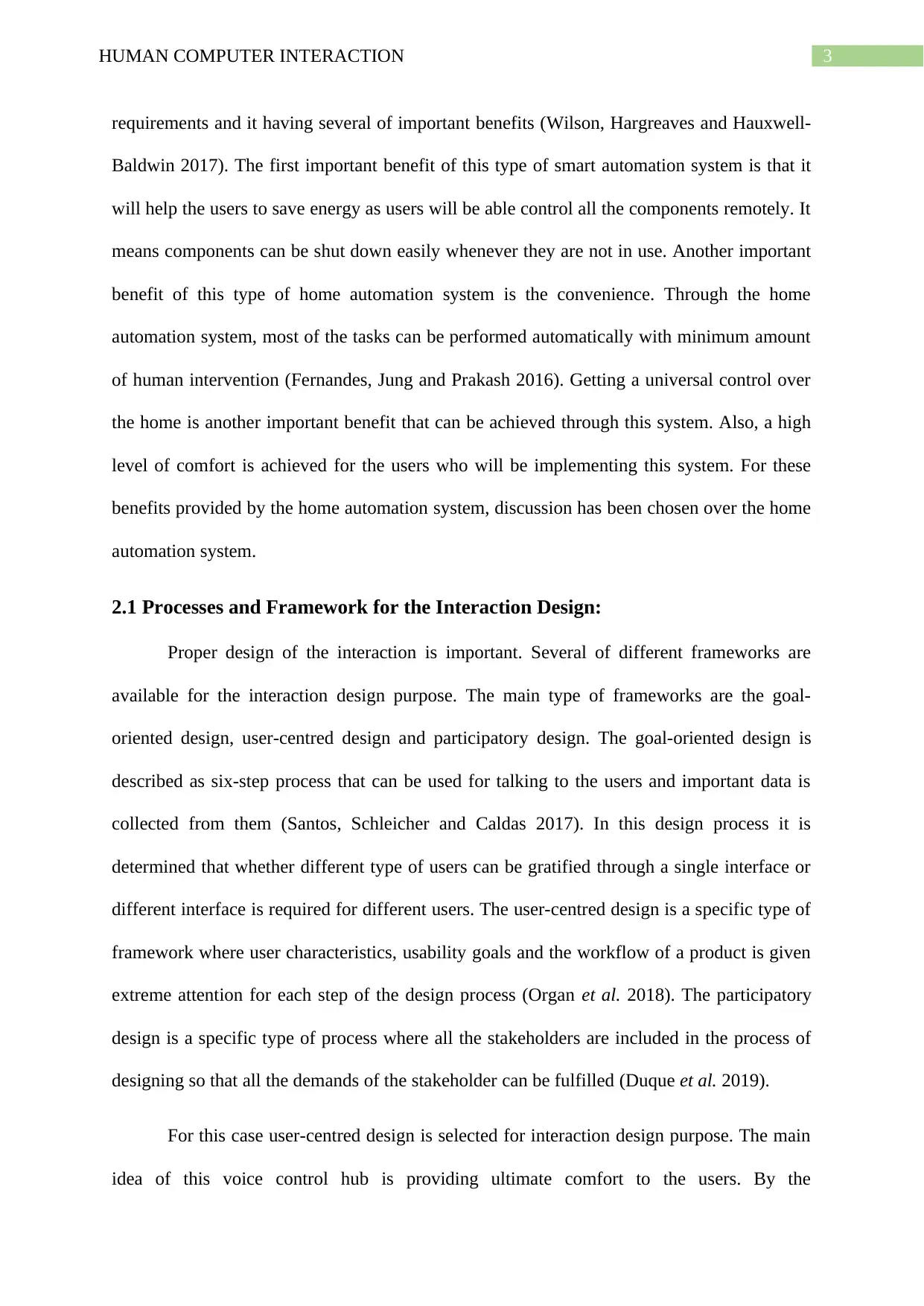
3HUMAN COMPUTER INTERACTION
requirements and it having several of important benefits (Wilson, Hargreaves and Hauxwell-
Baldwin 2017). The first important benefit of this type of smart automation system is that it
will help the users to save energy as users will be able control all the components remotely. It
means components can be shut down easily whenever they are not in use. Another important
benefit of this type of home automation system is the convenience. Through the home
automation system, most of the tasks can be performed automatically with minimum amount
of human intervention (Fernandes, Jung and Prakash 2016). Getting a universal control over
the home is another important benefit that can be achieved through this system. Also, a high
level of comfort is achieved for the users who will be implementing this system. For these
benefits provided by the home automation system, discussion has been chosen over the home
automation system.
2.1 Processes and Framework for the Interaction Design:
Proper design of the interaction is important. Several of different frameworks are
available for the interaction design purpose. The main type of frameworks are the goal-
oriented design, user-centred design and participatory design. The goal-oriented design is
described as six-step process that can be used for talking to the users and important data is
collected from them (Santos, Schleicher and Caldas 2017). In this design process it is
determined that whether different type of users can be gratified through a single interface or
different interface is required for different users. The user-centred design is a specific type of
framework where user characteristics, usability goals and the workflow of a product is given
extreme attention for each step of the design process (Organ et al. 2018). The participatory
design is a specific type of process where all the stakeholders are included in the process of
designing so that all the demands of the stakeholder can be fulfilled (Duque et al. 2019).
For this case user-centred design is selected for interaction design purpose. The main
idea of this voice control hub is providing ultimate comfort to the users. By the
requirements and it having several of important benefits (Wilson, Hargreaves and Hauxwell-
Baldwin 2017). The first important benefit of this type of smart automation system is that it
will help the users to save energy as users will be able control all the components remotely. It
means components can be shut down easily whenever they are not in use. Another important
benefit of this type of home automation system is the convenience. Through the home
automation system, most of the tasks can be performed automatically with minimum amount
of human intervention (Fernandes, Jung and Prakash 2016). Getting a universal control over
the home is another important benefit that can be achieved through this system. Also, a high
level of comfort is achieved for the users who will be implementing this system. For these
benefits provided by the home automation system, discussion has been chosen over the home
automation system.
2.1 Processes and Framework for the Interaction Design:
Proper design of the interaction is important. Several of different frameworks are
available for the interaction design purpose. The main type of frameworks are the goal-
oriented design, user-centred design and participatory design. The goal-oriented design is
described as six-step process that can be used for talking to the users and important data is
collected from them (Santos, Schleicher and Caldas 2017). In this design process it is
determined that whether different type of users can be gratified through a single interface or
different interface is required for different users. The user-centred design is a specific type of
framework where user characteristics, usability goals and the workflow of a product is given
extreme attention for each step of the design process (Organ et al. 2018). The participatory
design is a specific type of process where all the stakeholders are included in the process of
designing so that all the demands of the stakeholder can be fulfilled (Duque et al. 2019).
For this case user-centred design is selected for interaction design purpose. The main
idea of this voice control hub is providing ultimate comfort to the users. By the
Paraphrase This Document
Need a fresh take? Get an instant paraphrase of this document with our AI Paraphraser
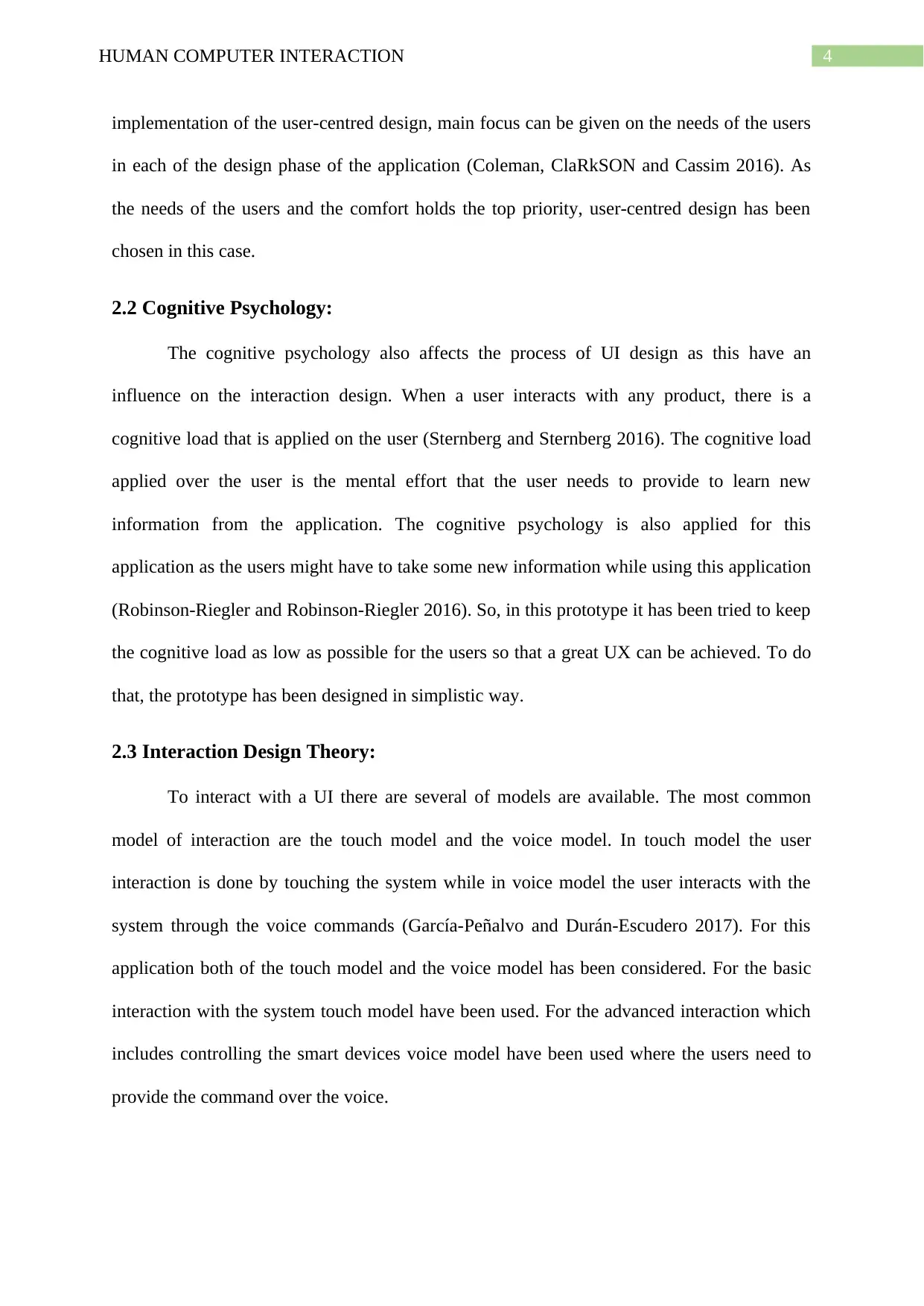
4HUMAN COMPUTER INTERACTION
implementation of the user-centred design, main focus can be given on the needs of the users
in each of the design phase of the application (Coleman, ClaRkSON and Cassim 2016). As
the needs of the users and the comfort holds the top priority, user-centred design has been
chosen in this case.
2.2 Cognitive Psychology:
The cognitive psychology also affects the process of UI design as this have an
influence on the interaction design. When a user interacts with any product, there is a
cognitive load that is applied on the user (Sternberg and Sternberg 2016). The cognitive load
applied over the user is the mental effort that the user needs to provide to learn new
information from the application. The cognitive psychology is also applied for this
application as the users might have to take some new information while using this application
(Robinson-Riegler and Robinson-Riegler 2016). So, in this prototype it has been tried to keep
the cognitive load as low as possible for the users so that a great UX can be achieved. To do
that, the prototype has been designed in simplistic way.
2.3 Interaction Design Theory:
To interact with a UI there are several of models are available. The most common
model of interaction are the touch model and the voice model. In touch model the user
interaction is done by touching the system while in voice model the user interacts with the
system through the voice commands (García-Peñalvo and Durán-Escudero 2017). For this
application both of the touch model and the voice model has been considered. For the basic
interaction with the system touch model have been used. For the advanced interaction which
includes controlling the smart devices voice model have been used where the users need to
provide the command over the voice.
implementation of the user-centred design, main focus can be given on the needs of the users
in each of the design phase of the application (Coleman, ClaRkSON and Cassim 2016). As
the needs of the users and the comfort holds the top priority, user-centred design has been
chosen in this case.
2.2 Cognitive Psychology:
The cognitive psychology also affects the process of UI design as this have an
influence on the interaction design. When a user interacts with any product, there is a
cognitive load that is applied on the user (Sternberg and Sternberg 2016). The cognitive load
applied over the user is the mental effort that the user needs to provide to learn new
information from the application. The cognitive psychology is also applied for this
application as the users might have to take some new information while using this application
(Robinson-Riegler and Robinson-Riegler 2016). So, in this prototype it has been tried to keep
the cognitive load as low as possible for the users so that a great UX can be achieved. To do
that, the prototype has been designed in simplistic way.
2.3 Interaction Design Theory:
To interact with a UI there are several of models are available. The most common
model of interaction are the touch model and the voice model. In touch model the user
interaction is done by touching the system while in voice model the user interacts with the
system through the voice commands (García-Peñalvo and Durán-Escudero 2017). For this
application both of the touch model and the voice model has been considered. For the basic
interaction with the system touch model have been used. For the advanced interaction which
includes controlling the smart devices voice model have been used where the users need to
provide the command over the voice.
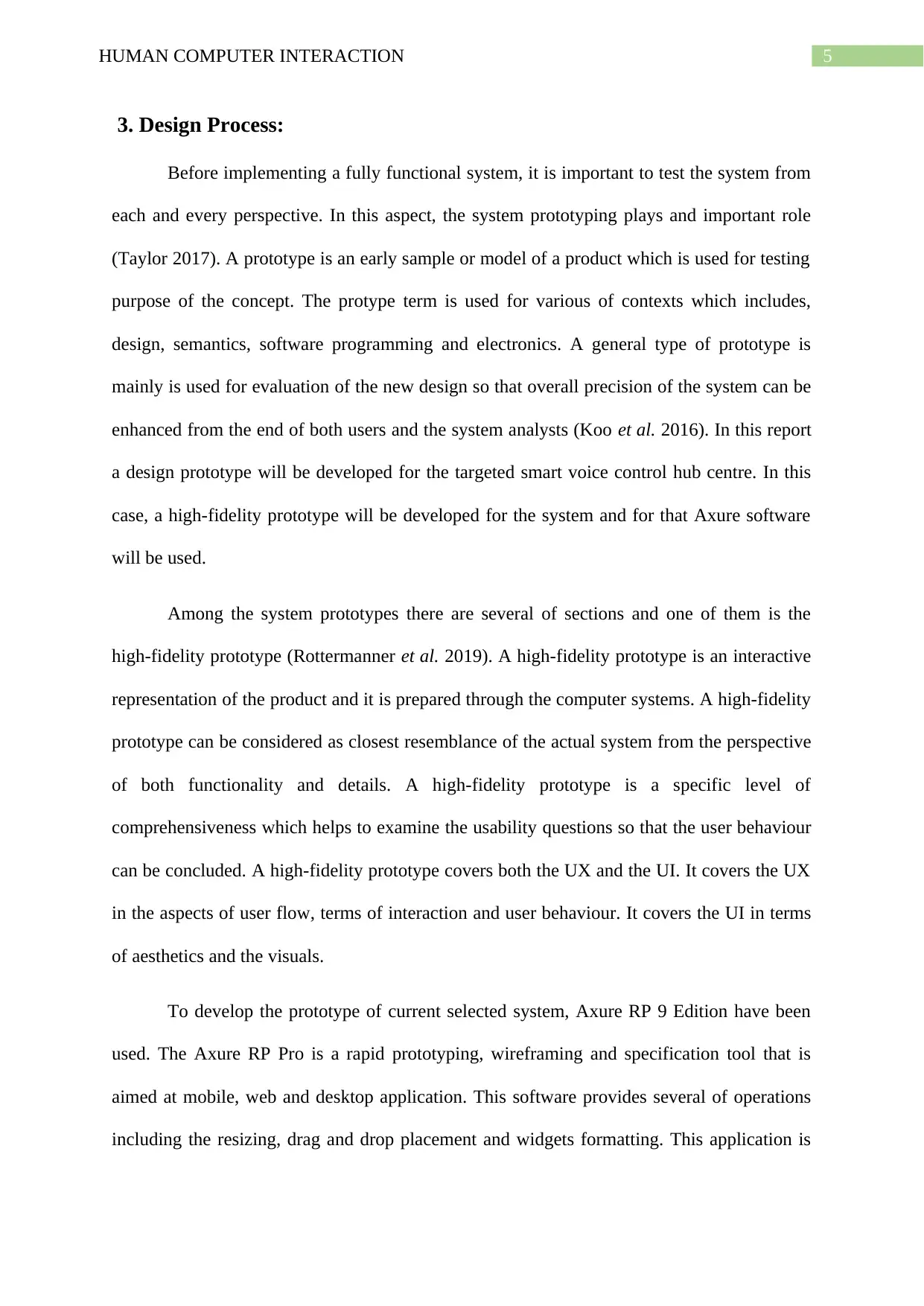
5HUMAN COMPUTER INTERACTION
3. Design Process:
Before implementing a fully functional system, it is important to test the system from
each and every perspective. In this aspect, the system prototyping plays and important role
(Taylor 2017). A prototype is an early sample or model of a product which is used for testing
purpose of the concept. The protype term is used for various of contexts which includes,
design, semantics, software programming and electronics. A general type of prototype is
mainly is used for evaluation of the new design so that overall precision of the system can be
enhanced from the end of both users and the system analysts (Koo et al. 2016). In this report
a design prototype will be developed for the targeted smart voice control hub centre. In this
case, a high-fidelity prototype will be developed for the system and for that Axure software
will be used.
Among the system prototypes there are several of sections and one of them is the
high-fidelity prototype (Rottermanner et al. 2019). A high-fidelity prototype is an interactive
representation of the product and it is prepared through the computer systems. A high-fidelity
prototype can be considered as closest resemblance of the actual system from the perspective
of both functionality and details. A high-fidelity prototype is a specific level of
comprehensiveness which helps to examine the usability questions so that the user behaviour
can be concluded. A high-fidelity prototype covers both the UX and the UI. It covers the UX
in the aspects of user flow, terms of interaction and user behaviour. It covers the UI in terms
of aesthetics and the visuals.
To develop the prototype of current selected system, Axure RP 9 Edition have been
used. The Axure RP Pro is a rapid prototyping, wireframing and specification tool that is
aimed at mobile, web and desktop application. This software provides several of operations
including the resizing, drag and drop placement and widgets formatting. This application is
3. Design Process:
Before implementing a fully functional system, it is important to test the system from
each and every perspective. In this aspect, the system prototyping plays and important role
(Taylor 2017). A prototype is an early sample or model of a product which is used for testing
purpose of the concept. The protype term is used for various of contexts which includes,
design, semantics, software programming and electronics. A general type of prototype is
mainly is used for evaluation of the new design so that overall precision of the system can be
enhanced from the end of both users and the system analysts (Koo et al. 2016). In this report
a design prototype will be developed for the targeted smart voice control hub centre. In this
case, a high-fidelity prototype will be developed for the system and for that Axure software
will be used.
Among the system prototypes there are several of sections and one of them is the
high-fidelity prototype (Rottermanner et al. 2019). A high-fidelity prototype is an interactive
representation of the product and it is prepared through the computer systems. A high-fidelity
prototype can be considered as closest resemblance of the actual system from the perspective
of both functionality and details. A high-fidelity prototype is a specific level of
comprehensiveness which helps to examine the usability questions so that the user behaviour
can be concluded. A high-fidelity prototype covers both the UX and the UI. It covers the UX
in the aspects of user flow, terms of interaction and user behaviour. It covers the UI in terms
of aesthetics and the visuals.
To develop the prototype of current selected system, Axure RP 9 Edition have been
used. The Axure RP Pro is a rapid prototyping, wireframing and specification tool that is
aimed at mobile, web and desktop application. This software provides several of operations
including the resizing, drag and drop placement and widgets formatting. This application is
⊘ This is a preview!⊘
Do you want full access?
Subscribe today to unlock all pages.

Trusted by 1+ million students worldwide
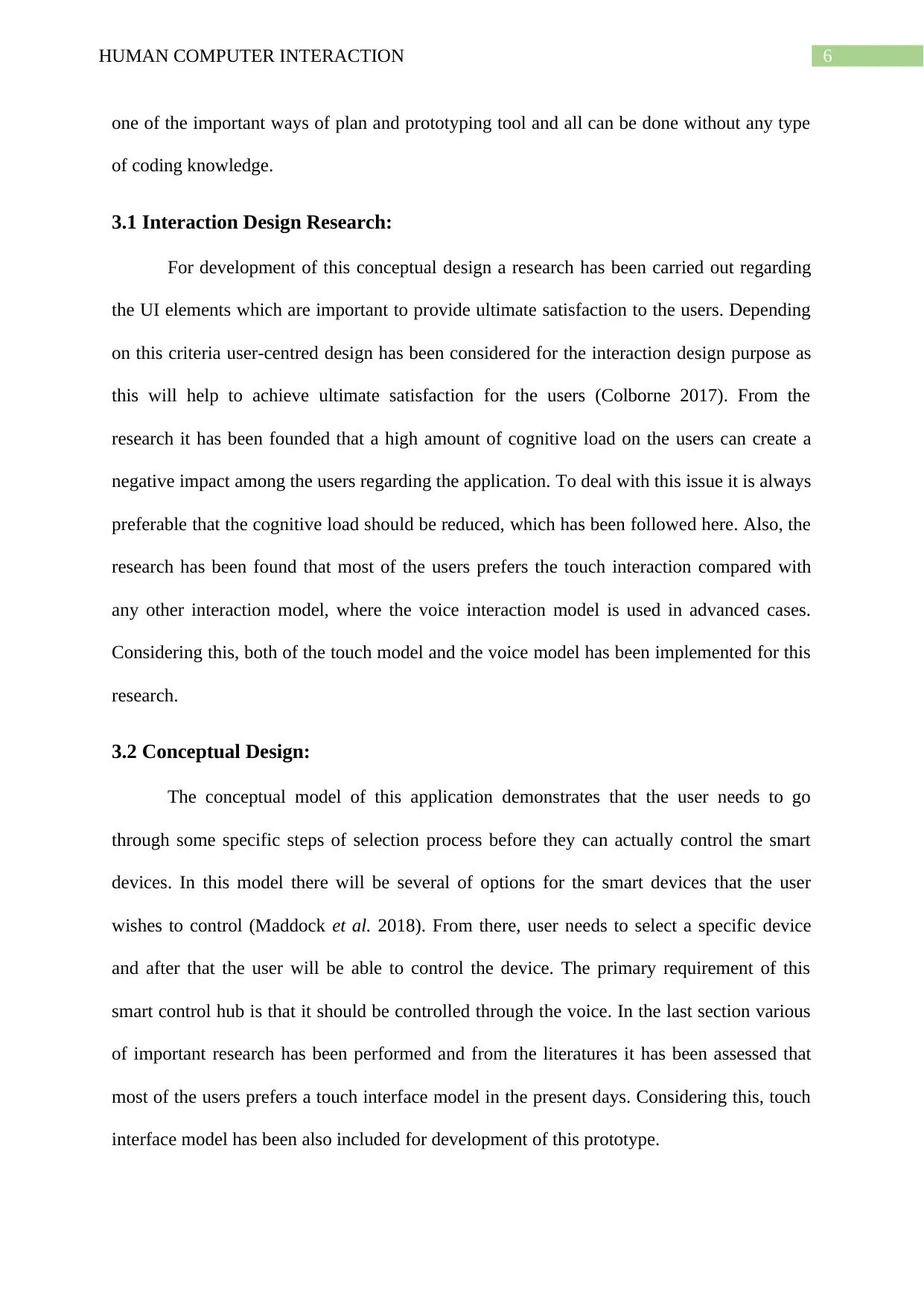
6HUMAN COMPUTER INTERACTION
one of the important ways of plan and prototyping tool and all can be done without any type
of coding knowledge.
3.1 Interaction Design Research:
For development of this conceptual design a research has been carried out regarding
the UI elements which are important to provide ultimate satisfaction to the users. Depending
on this criteria user-centred design has been considered for the interaction design purpose as
this will help to achieve ultimate satisfaction for the users (Colborne 2017). From the
research it has been founded that a high amount of cognitive load on the users can create a
negative impact among the users regarding the application. To deal with this issue it is always
preferable that the cognitive load should be reduced, which has been followed here. Also, the
research has been found that most of the users prefers the touch interaction compared with
any other interaction model, where the voice interaction model is used in advanced cases.
Considering this, both of the touch model and the voice model has been implemented for this
research.
3.2 Conceptual Design:
The conceptual model of this application demonstrates that the user needs to go
through some specific steps of selection process before they can actually control the smart
devices. In this model there will be several of options for the smart devices that the user
wishes to control (Maddock et al. 2018). From there, user needs to select a specific device
and after that the user will be able to control the device. The primary requirement of this
smart control hub is that it should be controlled through the voice. In the last section various
of important research has been performed and from the literatures it has been assessed that
most of the users prefers a touch interface model in the present days. Considering this, touch
interface model has been also included for development of this prototype.
one of the important ways of plan and prototyping tool and all can be done without any type
of coding knowledge.
3.1 Interaction Design Research:
For development of this conceptual design a research has been carried out regarding
the UI elements which are important to provide ultimate satisfaction to the users. Depending
on this criteria user-centred design has been considered for the interaction design purpose as
this will help to achieve ultimate satisfaction for the users (Colborne 2017). From the
research it has been founded that a high amount of cognitive load on the users can create a
negative impact among the users regarding the application. To deal with this issue it is always
preferable that the cognitive load should be reduced, which has been followed here. Also, the
research has been found that most of the users prefers the touch interaction compared with
any other interaction model, where the voice interaction model is used in advanced cases.
Considering this, both of the touch model and the voice model has been implemented for this
research.
3.2 Conceptual Design:
The conceptual model of this application demonstrates that the user needs to go
through some specific steps of selection process before they can actually control the smart
devices. In this model there will be several of options for the smart devices that the user
wishes to control (Maddock et al. 2018). From there, user needs to select a specific device
and after that the user will be able to control the device. The primary requirement of this
smart control hub is that it should be controlled through the voice. In the last section various
of important research has been performed and from the literatures it has been assessed that
most of the users prefers a touch interface model in the present days. Considering this, touch
interface model has been also included for development of this prototype.
Paraphrase This Document
Need a fresh take? Get an instant paraphrase of this document with our AI Paraphraser
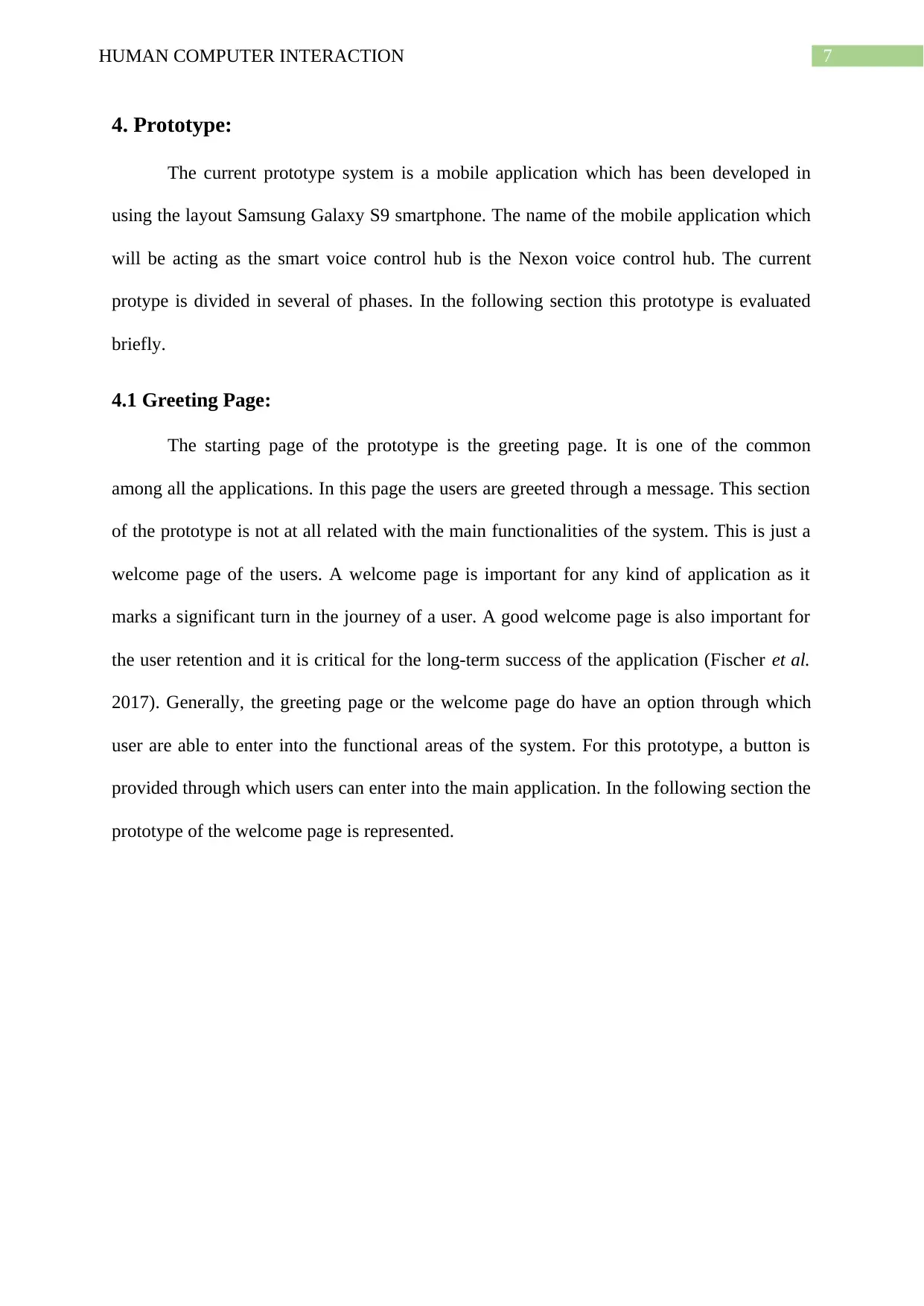
7HUMAN COMPUTER INTERACTION
4. Prototype:
The current prototype system is a mobile application which has been developed in
using the layout Samsung Galaxy S9 smartphone. The name of the mobile application which
will be acting as the smart voice control hub is the Nexon voice control hub. The current
protype is divided in several of phases. In the following section this prototype is evaluated
briefly.
4.1 Greeting Page:
The starting page of the prototype is the greeting page. It is one of the common
among all the applications. In this page the users are greeted through a message. This section
of the prototype is not at all related with the main functionalities of the system. This is just a
welcome page of the users. A welcome page is important for any kind of application as it
marks a significant turn in the journey of a user. A good welcome page is also important for
the user retention and it is critical for the long-term success of the application (Fischer et al.
2017). Generally, the greeting page or the welcome page do have an option through which
user are able to enter into the functional areas of the system. For this prototype, a button is
provided through which users can enter into the main application. In the following section the
prototype of the welcome page is represented.
4. Prototype:
The current prototype system is a mobile application which has been developed in
using the layout Samsung Galaxy S9 smartphone. The name of the mobile application which
will be acting as the smart voice control hub is the Nexon voice control hub. The current
protype is divided in several of phases. In the following section this prototype is evaluated
briefly.
4.1 Greeting Page:
The starting page of the prototype is the greeting page. It is one of the common
among all the applications. In this page the users are greeted through a message. This section
of the prototype is not at all related with the main functionalities of the system. This is just a
welcome page of the users. A welcome page is important for any kind of application as it
marks a significant turn in the journey of a user. A good welcome page is also important for
the user retention and it is critical for the long-term success of the application (Fischer et al.
2017). Generally, the greeting page or the welcome page do have an option through which
user are able to enter into the functional areas of the system. For this prototype, a button is
provided through which users can enter into the main application. In the following section the
prototype of the welcome page is represented.
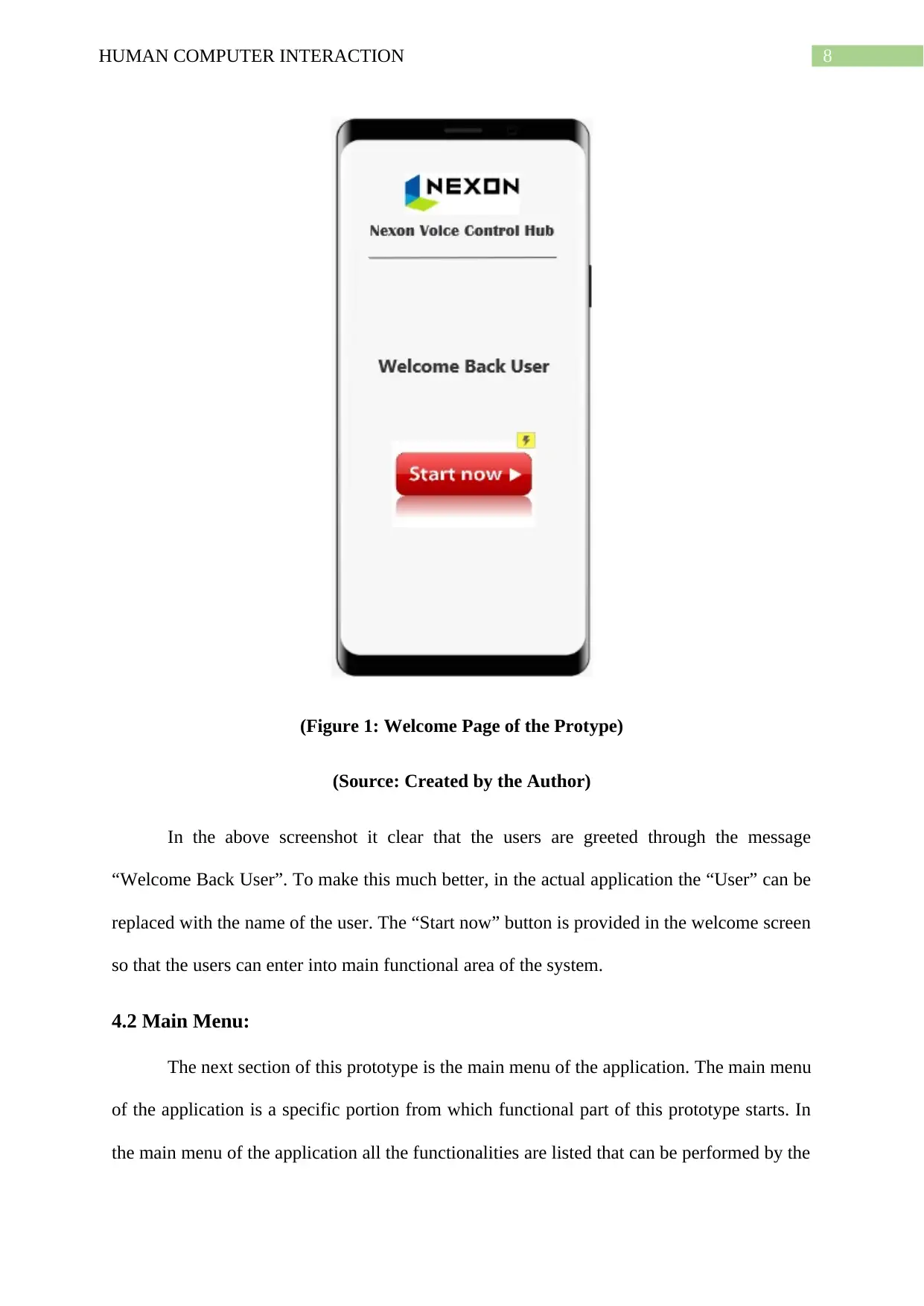
8HUMAN COMPUTER INTERACTION
(Figure 1: Welcome Page of the Protype)
(Source: Created by the Author)
In the above screenshot it clear that the users are greeted through the message
“Welcome Back User”. To make this much better, in the actual application the “User” can be
replaced with the name of the user. The “Start now” button is provided in the welcome screen
so that the users can enter into main functional area of the system.
4.2 Main Menu:
The next section of this prototype is the main menu of the application. The main menu
of the application is a specific portion from which functional part of this prototype starts. In
the main menu of the application all the functionalities are listed that can be performed by the
(Figure 1: Welcome Page of the Protype)
(Source: Created by the Author)
In the above screenshot it clear that the users are greeted through the message
“Welcome Back User”. To make this much better, in the actual application the “User” can be
replaced with the name of the user. The “Start now” button is provided in the welcome screen
so that the users can enter into main functional area of the system.
4.2 Main Menu:
The next section of this prototype is the main menu of the application. The main menu
of the application is a specific portion from which functional part of this prototype starts. In
the main menu of the application all the functionalities are listed that can be performed by the
⊘ This is a preview!⊘
Do you want full access?
Subscribe today to unlock all pages.

Trusted by 1+ million students worldwide
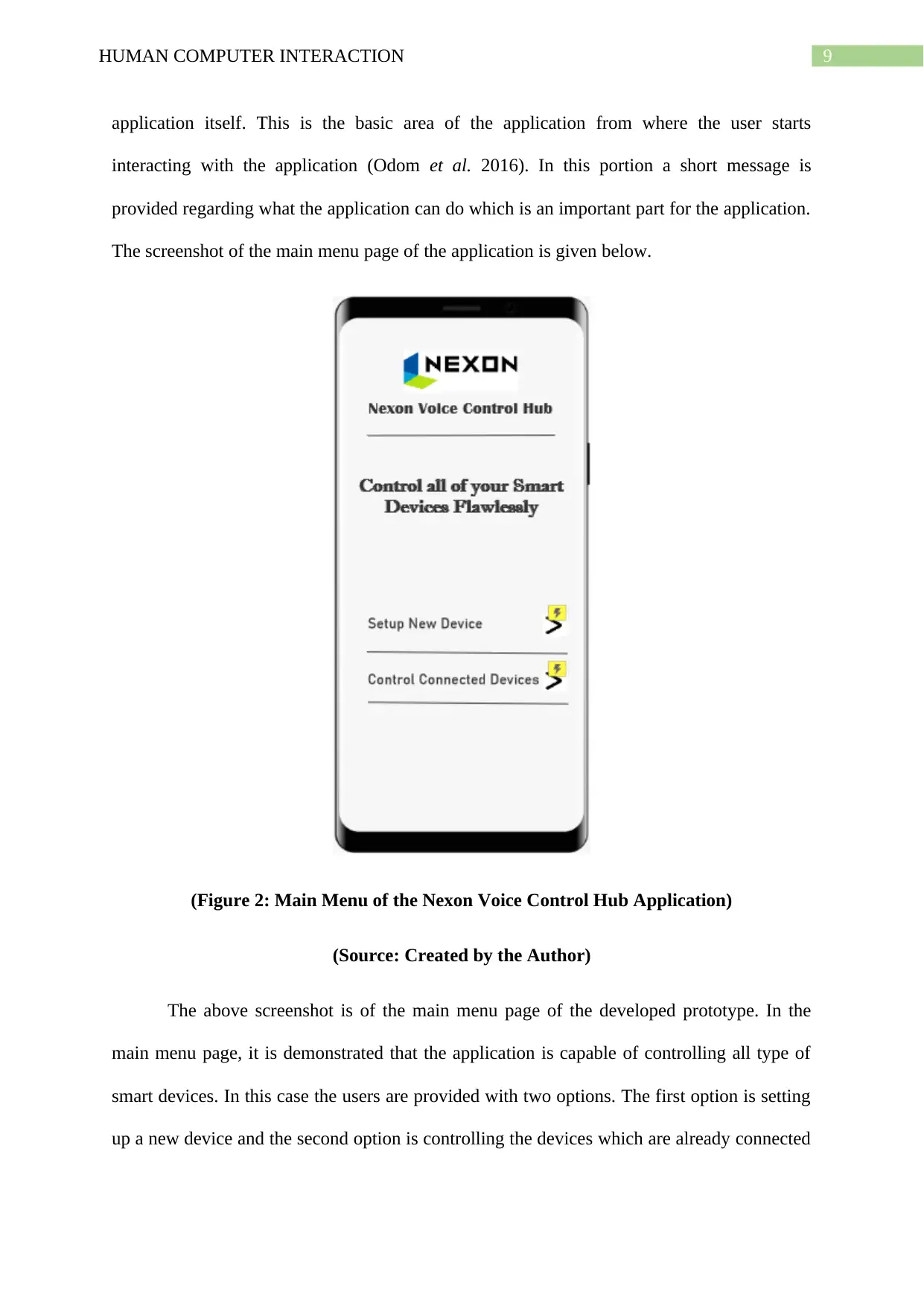
9HUMAN COMPUTER INTERACTION
application itself. This is the basic area of the application from where the user starts
interacting with the application (Odom et al. 2016). In this portion a short message is
provided regarding what the application can do which is an important part for the application.
The screenshot of the main menu page of the application is given below.
(Figure 2: Main Menu of the Nexon Voice Control Hub Application)
(Source: Created by the Author)
The above screenshot is of the main menu page of the developed prototype. In the
main menu page, it is demonstrated that the application is capable of controlling all type of
smart devices. In this case the users are provided with two options. The first option is setting
up a new device and the second option is controlling the devices which are already connected
application itself. This is the basic area of the application from where the user starts
interacting with the application (Odom et al. 2016). In this portion a short message is
provided regarding what the application can do which is an important part for the application.
The screenshot of the main menu page of the application is given below.
(Figure 2: Main Menu of the Nexon Voice Control Hub Application)
(Source: Created by the Author)
The above screenshot is of the main menu page of the developed prototype. In the
main menu page, it is demonstrated that the application is capable of controlling all type of
smart devices. In this case the users are provided with two options. The first option is setting
up a new device and the second option is controlling the devices which are already connected
Paraphrase This Document
Need a fresh take? Get an instant paraphrase of this document with our AI Paraphraser
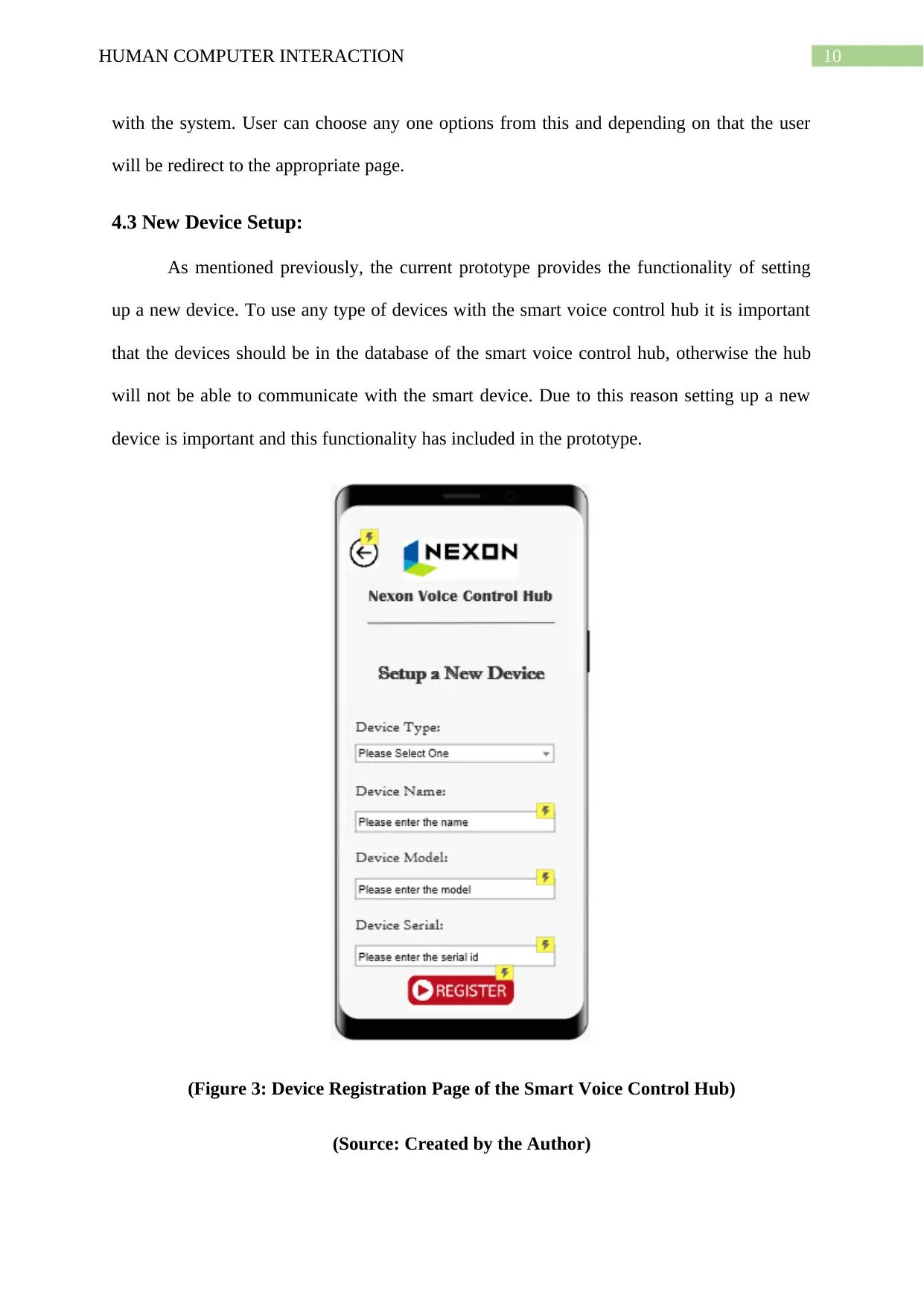
10HUMAN COMPUTER INTERACTION
with the system. User can choose any one options from this and depending on that the user
will be redirect to the appropriate page.
4.3 New Device Setup:
As mentioned previously, the current prototype provides the functionality of setting
up a new device. To use any type of devices with the smart voice control hub it is important
that the devices should be in the database of the smart voice control hub, otherwise the hub
will not be able to communicate with the smart device. Due to this reason setting up a new
device is important and this functionality has included in the prototype.
(Figure 3: Device Registration Page of the Smart Voice Control Hub)
(Source: Created by the Author)
with the system. User can choose any one options from this and depending on that the user
will be redirect to the appropriate page.
4.3 New Device Setup:
As mentioned previously, the current prototype provides the functionality of setting
up a new device. To use any type of devices with the smart voice control hub it is important
that the devices should be in the database of the smart voice control hub, otherwise the hub
will not be able to communicate with the smart device. Due to this reason setting up a new
device is important and this functionality has included in the prototype.
(Figure 3: Device Registration Page of the Smart Voice Control Hub)
(Source: Created by the Author)
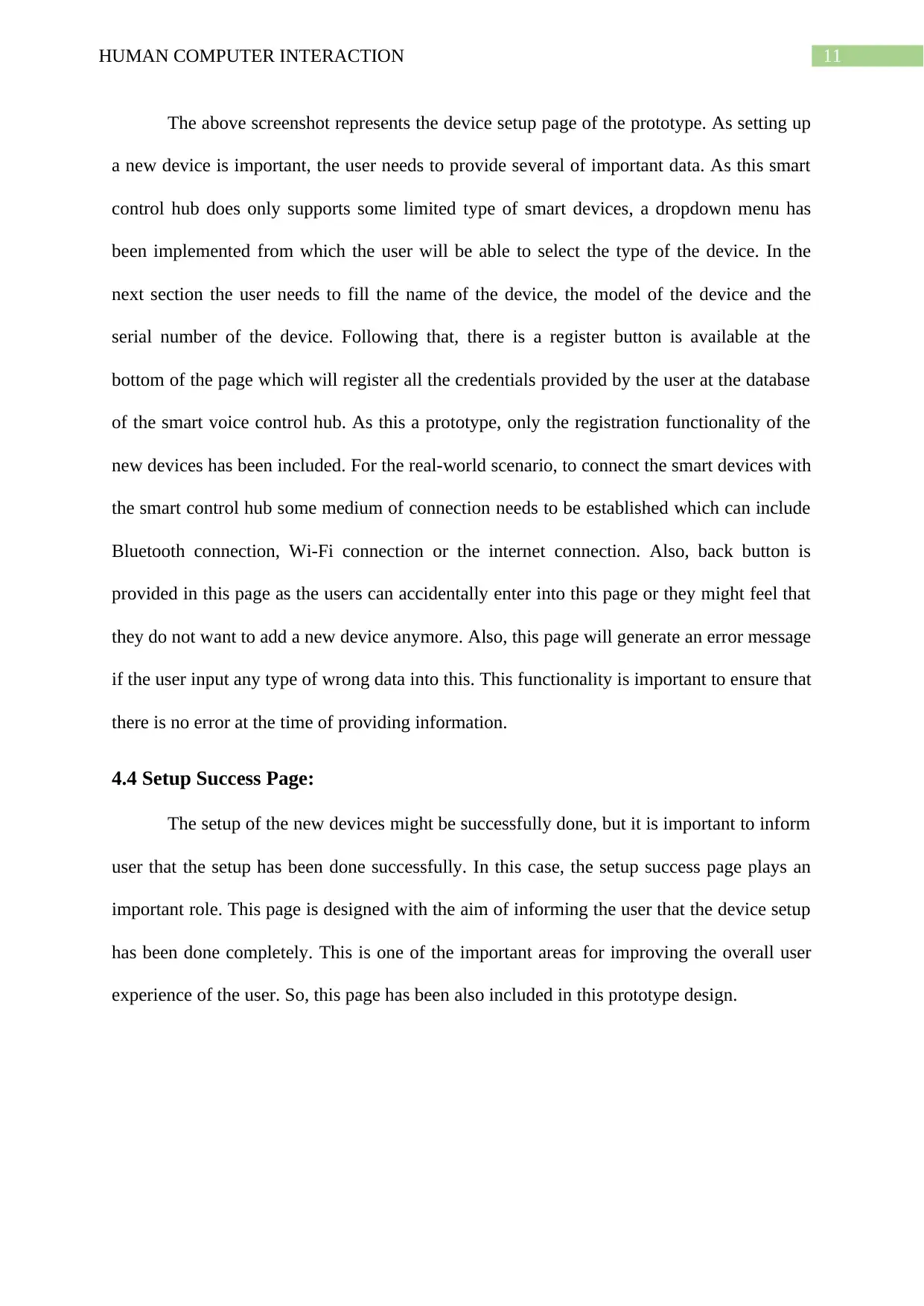
11HUMAN COMPUTER INTERACTION
The above screenshot represents the device setup page of the prototype. As setting up
a new device is important, the user needs to provide several of important data. As this smart
control hub does only supports some limited type of smart devices, a dropdown menu has
been implemented from which the user will be able to select the type of the device. In the
next section the user needs to fill the name of the device, the model of the device and the
serial number of the device. Following that, there is a register button is available at the
bottom of the page which will register all the credentials provided by the user at the database
of the smart voice control hub. As this a prototype, only the registration functionality of the
new devices has been included. For the real-world scenario, to connect the smart devices with
the smart control hub some medium of connection needs to be established which can include
Bluetooth connection, Wi-Fi connection or the internet connection. Also, back button is
provided in this page as the users can accidentally enter into this page or they might feel that
they do not want to add a new device anymore. Also, this page will generate an error message
if the user input any type of wrong data into this. This functionality is important to ensure that
there is no error at the time of providing information.
4.4 Setup Success Page:
The setup of the new devices might be successfully done, but it is important to inform
user that the setup has been done successfully. In this case, the setup success page plays an
important role. This page is designed with the aim of informing the user that the device setup
has been done completely. This is one of the important areas for improving the overall user
experience of the user. So, this page has been also included in this prototype design.
The above screenshot represents the device setup page of the prototype. As setting up
a new device is important, the user needs to provide several of important data. As this smart
control hub does only supports some limited type of smart devices, a dropdown menu has
been implemented from which the user will be able to select the type of the device. In the
next section the user needs to fill the name of the device, the model of the device and the
serial number of the device. Following that, there is a register button is available at the
bottom of the page which will register all the credentials provided by the user at the database
of the smart voice control hub. As this a prototype, only the registration functionality of the
new devices has been included. For the real-world scenario, to connect the smart devices with
the smart control hub some medium of connection needs to be established which can include
Bluetooth connection, Wi-Fi connection or the internet connection. Also, back button is
provided in this page as the users can accidentally enter into this page or they might feel that
they do not want to add a new device anymore. Also, this page will generate an error message
if the user input any type of wrong data into this. This functionality is important to ensure that
there is no error at the time of providing information.
4.4 Setup Success Page:
The setup of the new devices might be successfully done, but it is important to inform
user that the setup has been done successfully. In this case, the setup success page plays an
important role. This page is designed with the aim of informing the user that the device setup
has been done completely. This is one of the important areas for improving the overall user
experience of the user. So, this page has been also included in this prototype design.
⊘ This is a preview!⊘
Do you want full access?
Subscribe today to unlock all pages.

Trusted by 1+ million students worldwide
1 out of 24
Related Documents
Your All-in-One AI-Powered Toolkit for Academic Success.
+13062052269
info@desklib.com
Available 24*7 on WhatsApp / Email
![[object Object]](/_next/static/media/star-bottom.7253800d.svg)
Unlock your academic potential
Copyright © 2020–2025 A2Z Services. All Rights Reserved. Developed and managed by ZUCOL.




